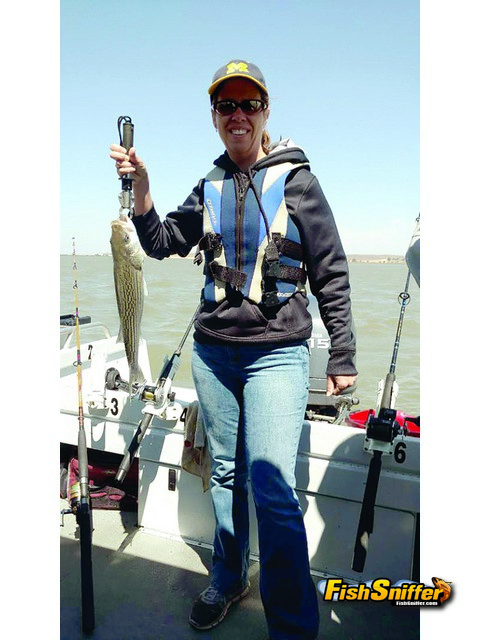The transitional period between summer and fall can be an uncertain time to fish in Northern California. Salmon are just starting show up in the river systems. Kokanee are turning into sockeye spawners. Sturgeon are active, but winds usually keep anglers from sitting on anchor in deep water. Have you ever struggled with the idea of what to fish for this time of year?
Striped bass typically start to move into the delta in late August or early September. If you can beat the winds, there are usually enough stripers around to make a trip worth your while. Are you one of those people who thinks that successful delta anglers have some secret bait or lure?
In my opinion, mastering the delta comes down to understanding a few key components, and one of them is the wind. Menacing winds blowing in the opposite direction of the current will stir up rolling swells topped with white caps.

These conditions are great for kitesurfing, but make fishing both unpleasant and unsafe when fishing from a boat. I have driven my boat with the swells, and measured them moving at over 12 miles per hour! If you are unfamiliar with the delta, stick to the smaller sloughs with high levees to avoid the chop.
On unprotected waters, one strategy when dealing with the wind is to anchor in a spot where the wind will be at your back. The swells won’t be nearly as large, and if you have a windshield or top on your boat, you will be mostly protected. Checking the wind and tide forecasts before you leave the house will make for a much more pleasurable trip if you plan accordingly.
The tides not only affect the current direction, but they also help to predict when the fish will bite. Whether you use a website, app, or tide book, knowing the tides is a crucial part of fishing the delta.
People often ask, “What is the best tide for striper fishing?” Generally speaking, the best time to fish is usually the hour before and the hour after the slack tide (or tide change). More specifically, the larger tides with fast current are better for bait fishing or plugging, while the slower tides are better for trolling.
I believe that the faster current that comes with big tides pushes more fish past you when you are fishing with bait. This is the same whether you are anchored in a boat or fishing from the shore. It increases your odds of catching more fish simply because more of them are passing by.
When bait fishing, I look for big tides that coincide with the full and new moon cycles. Conversely, the smaller tides that are better for trolling will be during the quarter moons (which look like half-moons in the sky). Trolling can be tough during big tides because the increased current flows stir up vegetation, which fouls up your trolling lures.
Loose aquatic plants in the water are abundant during the summer to fall transition period. Water plants grow quickly during the sunny summer months, and drifting vegetation can quickly foul up fishing lines this time of year. The way to counter this issue is to either move locations, or get into shallow water when bait fishing. In shallow water, you tend to have less line in the water. With less line out, there is less surface area for the vegetation to accumulate on and slide down to your bait.
On September 3rd, I headed to the west delta with my sister and her family to try out some late-summer striper fishing. I was hoping to get my two young nieces onto some stripers by soaking bait during a big outgoing tide. Unfortunately, the weather forecast was estimating strong westerly winds in the opposite direction of the tidal flows.

As the forecast had predicted, the wind was howling as we pulled into the Sherman Island launching facility. Once we were on the water, it was apparent that we would not be anchoring out in the main stretch of the Sacramento River as I had hoped. The outgoing tide was pushing against the west wind, and rolling swells were crashing into the shoreline as we pulled the boat into the main channel.
Plan ‘B’ had us fishing in Broad Slough, which was running perpendicular to the wind. Although the spot was near the levee and protected from the wind, we quickly learned that there was too much vegetation in the deep water. After only a few minutes of soaking bait, our lines would load up with huge balls of moss and vegetation.
With not many nearby options available due to the high winds, I decided to move into shallow water out in the middle of Broad Slough. We were out in the wind, but since it was hitting the current from the side, the swells were not an issue. Once anchored, I deployed drift socks on either side of the boat to keep the wind from swinging the boat too badly. If you don’t have drift socks, buckets on ropes will also work.
Once we got down to fishing, the bites came in waves. A school of stripers would move through, and several of the rods would get bit simultaneously. Then, a period of quiet would break up the action until another school would come along.
I put the first keeper into the boat, quickly followed by another one landed by my niece Leah. One by one, we each started hooking fish, including a nice eating-sized striper landed by my sister Rachel. By early afternoon, we had landed four keepers and decided to head for home.
As the weather transitions from summer into fall, stripers will continue to move into the delta in good numbers. Plan your trips around the tides and winds, and you will have a good chance of getting into some quality-sized striped bass. I hope to see you out there!
